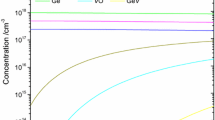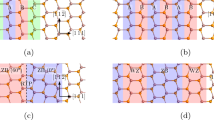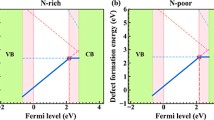Abstract
Obtaining high concentrations of active p-type dopants in HgCdTe is an issue of much current interest. We discuss the results of our calculations on column IB and VA dopants. The full-potential linear muffin-tin orbital method, based on the local density approximation is used to calculate electronic total energies and localized levels in the band gap. Free energies are predicted and incorporated into a thermodynamical model to calculate impurity and native defect concentrations as a function of temperature, stoichiometry, and total impurity density. Copper, silver, and gold are found to be incorporated nearly exclusively on the metal sublattice and to be 100% active for all near-equilibrium growth and processing conditions. The density of interstitial copper is high enough to impact copper diffusion. In contrast, significant concentrations of phosphorus, arsenic, and antimony are found on the metal sublattice where they behave as n-type dopants, accounting for highly compensated, or even n-type material, depending on the equilibration temperature and equivalent mercury partial pressure.
Similar content being viewed by others
References
See for example, L.O. Bubulac, J. Bajaj, W.E. Temmant, M. Zandian, J. Pasko and W.V. McLevige, J. Electron. Mater. 25, 1312 (1996); P.S. Wijewarnasuriya, S.S. Yoo, J.P. Faurie and S. Sivananthan, J. Electron. Mater. 25,1300 (1996); P. Mitra, Y.L. Tyan., F.C. Case, R. Starr and M.B. Reine, J. Electron. Mater. 25, 1328 (1996); S.H. Shin, J.M. Arias, M. Zandian, J.G. Pasko, L.O. Bubulac and R.E. De Wames, J. Electron. Mater. 24, 609 (1995).
H.R. Vydyanath, Semicon. Sci. Technol. 5, 213 (1990).
U. von Barth and L. Hedin, J. Phys. C 5, 1629 (1972).
M.A. Berding, M. van Schilfgaarde and A. Sher, Phys. Rev. B 50, 1519 (1994).
For a general discussion of the density functional formalism, upon which LDA is based, and its various modifications, see R.O. Jones and O. Gunnarsson, Rev. Mod. Phys. 61, 689 (1989).
D. Langreth and D. Mehl, Phys. Rev. B 28, 1809 (1983).
D. Chandra, M.W. Goodwin, M.C. Chen and J.A. Dodge, J. Electron. Mater. 22, 1033 (1993); S.H. Shin, J.M. Arias, M. Zandian, J.G. Pasko, L.O. Bubulac and R.E. De Wames, J. Electron. Mater. 24, 609 (1995).
Author information
Authors and Affiliations
Rights and permissions
About this article
Cite this article
Berding, M.A., Sher, A. & Van Schilfgaarde, M. Behavior of p-type dopants in HgCdTe. J. Electron. Mater. 26, 625–628 (1997). https://doi.org/10.1007/s11664-997-0206-5
Received:
Accepted:
Issue Date:
DOI: https://doi.org/10.1007/s11664-997-0206-5




